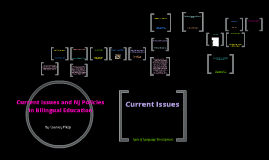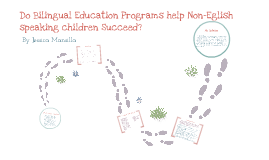Bilingual Education
Transcript: The U.S. founders envisioned "a country with a unified history, with unified traditions, and with a common language" (Ovando, 2003, pg. 2). Basic Timeline of U.S. bilingual EducationThe Permissive Period 1700s-1880s: During the time there was some acceptance or at least tolerance of other languages (although often limited to European languages). The Restrictive Period 1880s-1960s: During this time there was a repression of Native American Languages. There was also increased fear calling for the assimilation of immigrants (i.e. The Naturalization Act of 1906 that required speaking English to be a naturalized citizen.) The Opportunist Period 1960s-1980s: During World War II promoted the need for educating students in more than one language, promoting foreign language instruction for English speaking students, but by forcing assimilation and English monolingualism on non-English speakers, essential destroying a key group of bilingual students. During the Cuban Revolution (1959), Cubans fleeing to the U.S. resisted assimilitation because they did not plan on staying. They helped to establish bilingual programs in Florida to help their children maintain Spanish while learning English. During this time the The Bilingual Education Act was passed (1968). The Dismissive Period 1980s-present: Presidents Reagan was quoted "It is absolutely wrong and against American concepts to have a bilingual education program that is now openly, admittedly dedicated to preserving their native language and never getting them adequate in English so they can go out into the job market and participate." There was a general shift in funds toward English only programs (Ovando, 2003, p. 4-13). The Bilingual Education Act This was an ambiguous act, which has been debated for the past 30 years. Ultimately, it was the first step away from the sink-or-swim method of education. The act resulted in education programs that sought to utilize and build on students home cultures and languages (Ovando, 2003, pg. 11-13. The bilingual education Act was followed by Lau vs. Nichols which "legitimized and gave impetus to the movement for equal eduational opportunity for students who do not speak English." The Lau decision stated that providing all students with the same education does not make it equal (Ovando, 2003, pg.). Current Struggles in biligual education In June 1998 California passed Proposition 227.This proposed that English would be the primary language of instruction for language-minority students. Other states have passed, or are considering passing, similar laws. "All you need is Ennglish" has emerged as the semi-official status of the U.S. on bilingual education. No Child Left Behind essentially terminated the Bilingual Education Act. NCLB endorses acquiring English and fails to mention anything about bilingual education (Katz, 2004, p. 144). According to the 2000 census, almost 20% of the population uses languages other than English (Katz, 2004, p. 143). Monolingualism vs. Pluralingualism While the United States now focuses on the acquisition of English, European nations have embraced the notion of pluralingualism. In Europe children are provided the opportunity to develop literacy in their native language as well as the language of their community. In Europe students are encouraged to learn two even three or more langauges beginning at an early age. In the U.S. we stress one language, introducing the concept of learning a new langauge in high school, well past the age when the brain is more receptive to acquiring a new language (Katz, 2004, p. 144). It is often mentioned that language is a cultural resource. It is equally important that we realize that our bilingual, bicultural students are an equally important resource. Even if we cannot speak their language, we can take their experiences and their cultures,and use that to broaden our horizons, as well as those of our students (Katz, 2004, p. 141). Resources Ovando, C.J. (2003). Bilingual education in the United States: historical development and current issues. Bilingual Research Journal, 27(1), 1-25. Katz, S.R. (2004). Does NCLB leave the U.S. behind in bilingual teacher education?. English Education, 36(2), 141-153. As our country formed European languages were more likely to be respected and accepted, and speakers of these languages were often accomodated in schools (Ovando, 2003, pg. 2). Double click anywhere & add an idea

















